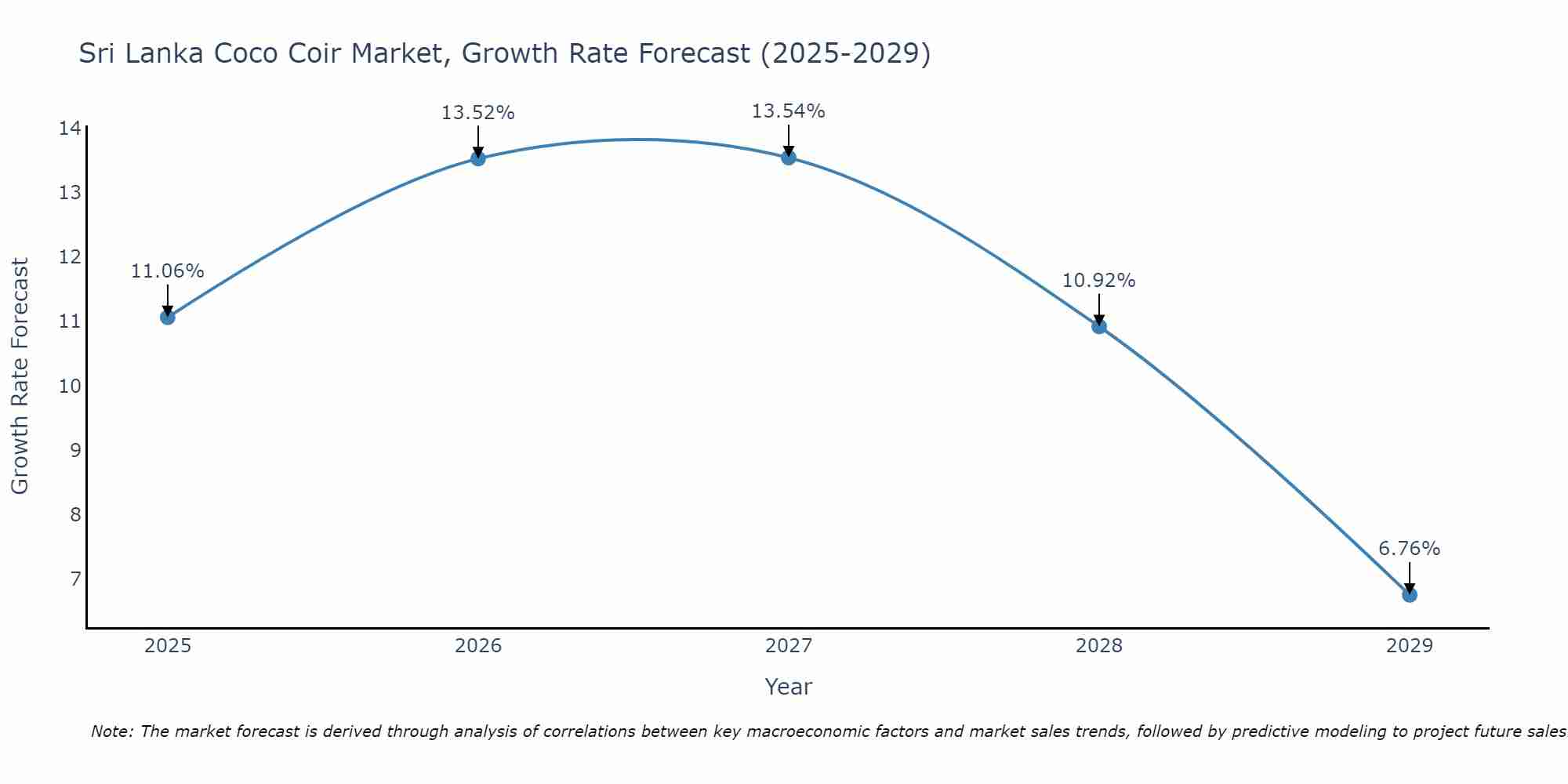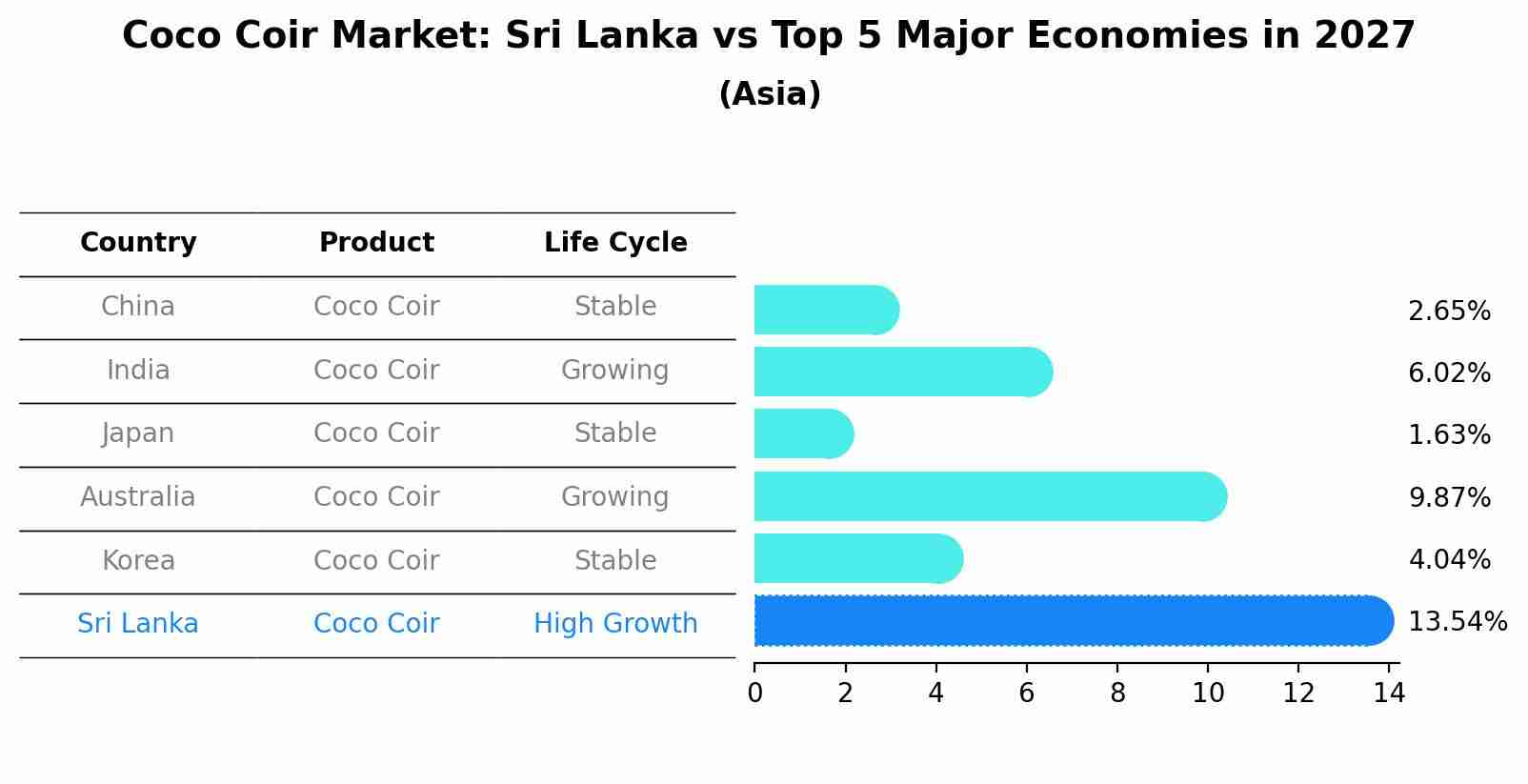Sri Lanka Coco Coir Market Outlook | COVID-19 IMPACT, Trends, Growth, Companies, Revenue, Value, Size, Industry, Share, Forecast & Analysis
| Product Code: ETC373711 | Publication Date: Aug 2022 | Updated Date: Jul 2025 | Product Type: Market Research Report | |
| Publisher: 6Wresearch | Author: Ravi Bhandari | No. of Pages: 75 | No. of Figures: 35 | No. of Tables: 20 |
Sri Lanka Coco Coir Market Size Growth Rate
The Sri Lanka Coco Coir Market is projected to witness mixed growth rate patterns during 2025 to 2029. The growth rate begins at 11.06% in 2025, climbs to a high of 13.54% in 2027, and moderates to 6.76% by 2029.

Coco Coir Market: Sri Lanka vs Top 5 Major Economies in 2027 (Asia)
By 2027, Sri Lanka's Coco Coir market is forecasted to achieve a high growth rate of 13.54%, with China leading the Asia region, followed by India, Japan, Australia and South Korea.

Sri Lanka Coco Coir Market Synopsis
The Sri Lanka Coco Coir Market is witnessing significant growth driven by the increasing demand for sustainable and eco-friendly products in agriculture and horticulture industries. Coco coir, derived from coconut husks, is valued for its superior water retention, aeration, and nutrient-holding capacity, making it an ideal alternative to traditional soil mediums. The market is experiencing a surge in export activities, with Sri Lanka being one of the largest global suppliers of coco coir products. The country`s tropical climate and abundance of coconut plantations contribute to the availability of high-quality raw materials for coco coir production. Key market players are focusing on product innovation and expanding their product portfolios to cater to diverse end-user applications such as hydroponics, landscaping, and soil conditioning. The Sri Lanka Coco Coir Market is poised for further expansion as eco-conscious consumers continue to prioritize sustainable agricultural practices.
Sri Lanka Coco Coir Market Trends
The Sri Lanka Coco Coir Market is experiencing significant growth due to the rising demand for eco-friendly and sustainable products globally. One of the key trends in the market is the increasing adoption of coco coir as a preferred growing medium in the horticulture and agriculture sectors. The superior water retention and aeration properties of coco coir make it an ideal alternative to traditional soil-based mediums. Additionally, the market is witnessing a surge in demand for value-added coco coir products such as coco peat, coco chips, and coco fiber as they find application in landscaping, erosion control, and as a substrate for animal bedding. The market is also seeing a growing focus on product innovation and sustainable practices to meet the evolving needs of customers and adhere to environmental regulations.
Sri Lanka Coco Coir Market Challenges
In the Sri Lanka Coco Coir Market, some challenges faced include fluctuating raw material prices due to climate change affecting coconut production, competition from alternative growing mediums like peat moss, and limited awareness among consumers about the benefits of using coco coir. Additionally, issues such as inconsistent quality standards, lack of standardized grading systems, and difficulties in transportation and logistics due to the island nation`s geography pose challenges for market players. Furthermore, the industry also grapples with the need for sustainable sourcing practices to maintain the ecological balance of coconut plantations. Overcoming these challenges will require investments in research and development, education initiatives to increase awareness, and collaborations within the supply chain to ensure quality and consistency in coco coir products.
Sri Lanka Coco Coir Market Investment Opportunities
Investment opportunities in the Sri Lanka Coco Coir market include investing in coco coir production facilities, expanding export capabilities, and developing innovative coco coir products. With the growing demand for eco-friendly and sustainable alternatives to traditional gardening and agriculture products, there is a significant opportunity to capitalize on the increasing global awareness of coco coir`s benefits. Investors can consider partnerships with local coco coir manufacturers to enhance production capacity and quality control measures. Additionally, exploring new markets and distribution channels can help to expand the reach of Sri Lankan coco coir products internationally. Investing in research and development to create value-added coco coir products for various industries can also open up new revenue streams in this growing market segment.
Jordan Agar Market Government Policies
The Sri Lankan government has several policies in place that impact the Coco Coir market, a significant industry in the country. These policies include incentives for the expansion and modernization of Coco Coir production facilities, subsidies for farmers and exporters, and regulations aimed at ensuring sustainable harvesting practices. Additionally, the government has implemented quality control measures to maintain high standards for Coco Coir products exported from Sri Lanka, enhancing the country`s reputation in the global market. Furthermore, there are efforts to promote research and development in the Coco Coir sector to improve product quality and explore new applications. Overall, these government policies play a crucial role in supporting the growth and competitiveness of the Sri Lankan Coco Coir industry both domestically and internationally.
Sri Lanka Coco Coir Market Future Outlook
The Sri Lanka Coco Coir market is poised for significant growth in the coming years due to the increasing demand for eco-friendly and sustainable products worldwide. Coco coir, being a renewable and biodegradable material, is gaining popularity as a substitute for peat moss in horticulture, agriculture, and landscaping applications. Sri Lanka`s reputation for producing high-quality coco coir products and the government`s support for the industry through initiatives such as the Coconut Development Authority are expected to drive market growth. Furthermore, the rising awareness among consumers about the environmental benefits of coco coir products is likely to fuel market demand. Overall, the future outlook for the Sri Lanka Coco Coir market appears promising, with opportunities for expansion both domestically and in international markets.
Key Highlights of the Report:
- Sri Lanka Coco Coir Market Outlook
- Market Size of Sri Lanka Coco Coir Market, 2021
- Forecast of Sri Lanka Coco Coir Market, 2031
- Historical Data and Forecast of Sri Lanka Coco Coir Revenues & Volume for the Period 2018 - 2031
- Sri Lanka Coco Coir Market Trend Evolution
- Sri Lanka Coco Coir Market Drivers and Challenges
- Sri Lanka Coco Coir Price Trends
- Sri Lanka Coco Coir Porter's Five Forces
- Sri Lanka Coco Coir Industry Life Cycle
- Historical Data and Forecast of Sri Lanka Coco Coir Market Revenues & Volume By Product for the Period 2018 - 2031
- Historical Data and Forecast of Sri Lanka Coco Coir Market Revenues & Volume By Coco Coir Grow Bags for the Period 2018 - 2031
- Historical Data and Forecast of Sri Lanka Coco Coir Market Revenues & Volume By Bales for the Period 2018 - 2031
- Historical Data and Forecast of Sri Lanka Coco Coir Market Revenues & Volume By Coir Material for the Period 2018 - 2031
- Historical Data and Forecast of Sri Lanka Coco Coir Market Revenues & Volume By Open Tops for the Period 2018 - 2031
- Historical Data and Forecast of Sri Lanka Coco Coir Market Revenues & Volume By Blends & Loose Substrate for the Period 2018 - 2031
- Historical Data and Forecast of Sri Lanka Coco Coir Market Revenues & Volume By Others for the Period 2018 - 2031
- Historical Data and Forecast of Sri Lanka Coco Coir Market Revenues & Volume By Application for the Period 2018 - 2031
- Historical Data and Forecast of Sri Lanka Coco Coir Market Revenues & Volume By Rope & Cordage for the Period 2018 - 2031
- Historical Data and Forecast of Sri Lanka Coco Coir Market Revenues & Volume By Coco Nets & Twines for the Period 2018 - 2031
- Historical Data and Forecast of Sri Lanka Coco Coir Market Revenues & Volume By Stitched Mats for the Period 2018 - 2031
- Historical Data and Forecast of Sri Lanka Coco Coir Market Revenues & Volume By Coconut Meals for the Period 2018 - 2031
- Historical Data and Forecast of Sri Lanka Coco Coir Market Revenues & Volume By Husk for the Period 2018 - 2031
- Historical Data and Forecast of Sri Lanka Coco Coir Market Revenues & Volume By Others for the Period 2018 - 2031
- Historical Data and Forecast of Sri Lanka Coco Coir Market Revenues & Volume By Consumer for the Period 2018 - 2031
- Historical Data and Forecast of Sri Lanka Coco Coir Market Revenues & Volume By Green Houses for the Period 2018 - 2031
- Historical Data and Forecast of Sri Lanka Coco Coir Market Revenues & Volume By Sellers for the Period 2018 - 2031
- Sri Lanka Coco Coir Import Export Trade Statistics
- Market Opportunity Assessment By Product
- Market Opportunity Assessment By Application
- Market Opportunity Assessment By Consumer
- Sri Lanka Coco Coir Top Companies Market Share
- Sri Lanka Coco Coir Competitive Benchmarking By Technical and Operational Parameters
- Sri Lanka Coco Coir Company Profiles
- Sri Lanka Coco Coir Key Strategic Recommendations
Frequently Asked Questions About the Market Study (FAQs):
- Single User License$ 1,995
- Department License$ 2,400
- Site License$ 3,120
- Global License$ 3,795
Search
Thought Leadership and Analyst Meet
Our Clients
Related Reports
- Canada Oil and Gas Market (2026-2032) | Share, Segmentation, Value, Industry, Trends, Forecast, Analysis, Size & Revenue, Growth, Competitive Landscape, Outlook, Companies
- Germany Breakfast Food Market (2026-2032) | Industry, Share, Growth, Size, Companies, Value, Analysis, Revenue, Trends, Forecast & Outlook
- Australia Briquette Market (2025-2031) | Growth, Size, Revenue, Forecast, Analysis, Trends, Value, Share, Industry & Companies
- Vietnam System Integrator Market (2025-2031) | Size, Companies, Analysis, Industry, Value, Forecast, Growth, Trends, Revenue & Share
- ASEAN and Thailand Brain Health Supplements Market (2025-2031) | Strategy, Consumer Insights, Analysis, Investment Trends, Opportunities, Growth, Size, Share, Industry, Revenue, Segments, Value, Segmentation, Supply, Forecast, Restraints, Outlook, Competition, Drivers, Trends, Demand, Pricing Analysis, Competitive, Strategic Insights, Companies, Challenges
- ASEAN Bearings Market (2025-2031) | Strategy, Consumer Insights, Analysis, Investment Trends, Opportunities, Growth, Size, Share, Industry, Revenue, Segments, Value, Segmentation, Supply, Forecast, Restraints, Outlook, Competition, Drivers, Trends, Demand, Pricing Analysis, Competitive, Strategic Insights, Companies, Challenges
- Europe Flooring Market (2025-2031) | Outlook, Share, Industry, Trends, Forecast, Companies, Revenue, Size, Analysis, Growth & Value
- Saudi Arabia Manlift Market (2025-2031) | Outlook, Size, Growth, Trends, Companies, Industry, Revenue, Value, Share, Forecast & Analysis
- Uganda Excavator, Crane, and Wheel Loaders Market (2025-2031) | Strategy, Consumer Insights, Analysis, Investment Trends, Opportunities, Growth, Size, Share, Industry, Revenue, Segments, Value, Segmentation, Supply, Forecast, Restraints, Outlook, Competition, Drivers, Trends, Demand, Pricing Analysis, Competitive, Strategic Insights, Companies, Challenges
- Rwanda Excavator, Crane, and Wheel Loaders Market (2025-2031) | Strategy, Consumer Insights, Analysis, Investment Trends, Opportunities, Growth, Size, Share, Industry, Revenue, Segments, Value, Segmentation, Supply, Forecast, Restraints, Outlook, Competition, Drivers, Trends, Demand, Pricing Analysis, Competitive, Strategic Insights, Companies, Challenges
Industry Events and Analyst Meet
Whitepaper
- Middle East & Africa Commercial Security Market Click here to view more.
- Middle East & Africa Fire Safety Systems & Equipment Market Click here to view more.
- GCC Drone Market Click here to view more.
- Middle East Lighting Fixture Market Click here to view more.
- GCC Physical & Perimeter Security Market Click here to view more.
6WResearch In News
- Doha a strategic location for EV manufacturing hub: IPA Qatar
- Demand for luxury TVs surging in the GCC, says Samsung
- Empowering Growth: The Thriving Journey of Bangladesh’s Cable Industry
- Demand for luxury TVs surging in the GCC, says Samsung
- Video call with a traditional healer? Once unthinkable, it’s now common in South Africa
- Intelligent Buildings To Smooth GCC’s Path To Net Zero


















